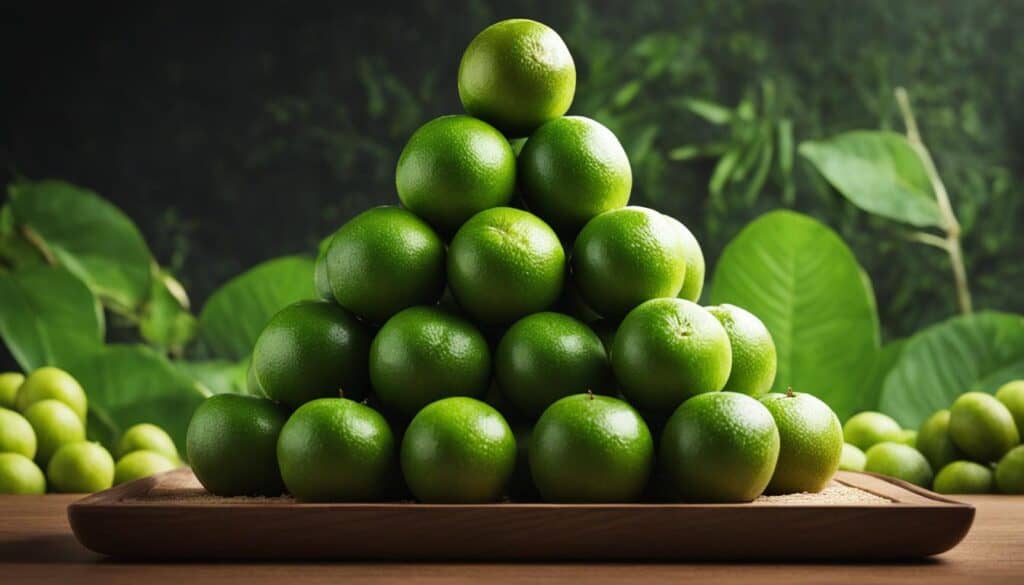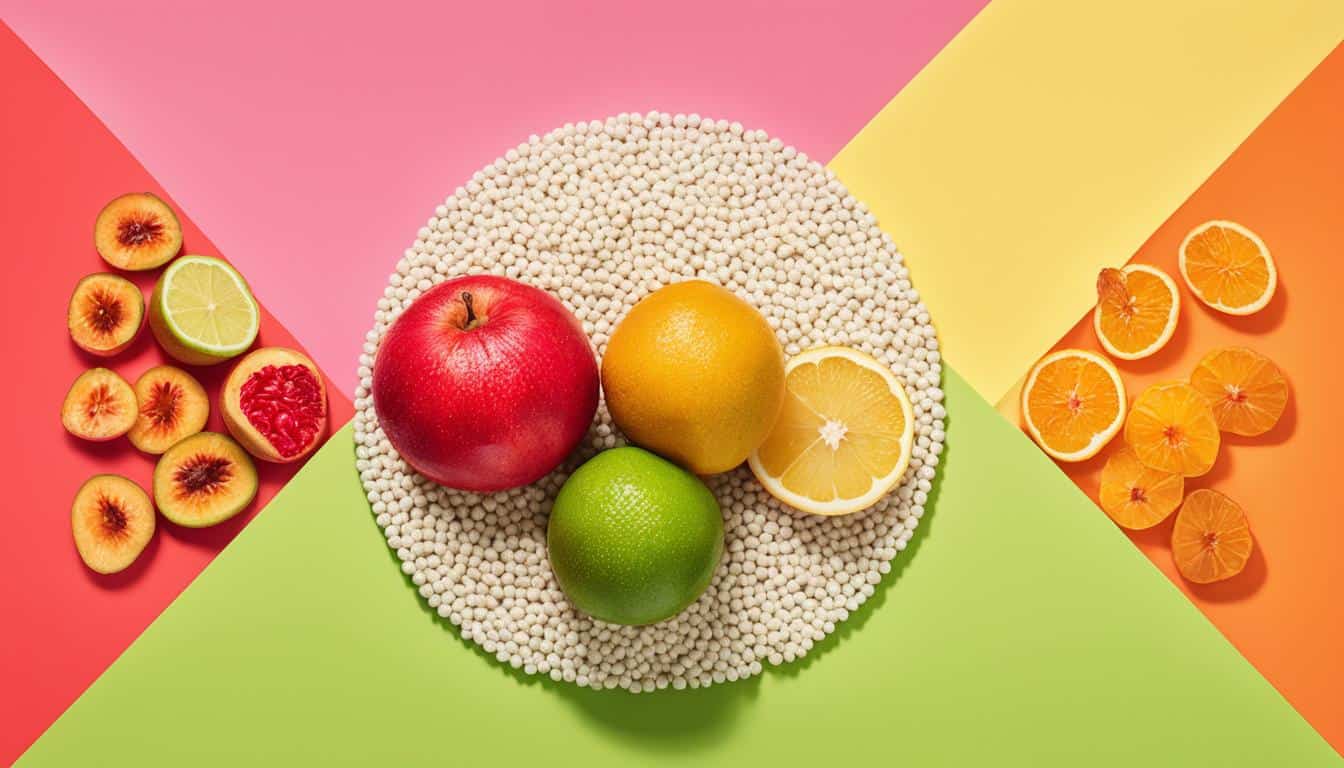When it comes to choosing a sweetener, the options can be overwhelming. Two natural alternatives that have gained popularity are monk fruit and allulose. But how do they compare? In this article, I will delve into the differences between monk fruit and allulose, explore their benefits, and examine how they stack up against sugar and other sweeteners.
Monk fruit is a non-nutritive high intensity sweetener that is 150-200 times sweeter than sugar. It has zero impact on blood sugar levels, making it an excellent choice for individuals with diabetes. Additionally, monk fruit contains antioxidant and anti-inflammatory properties, adding to its appeal as a natural sweetener.
Allulose, on the other hand, is a low-calorie sweetener that tastes identical to regular sugar. With zero glycemic index and about 70% of the sweetness of sugar, allulose is suitable for diabetes and keto diets. It is metabolized differently by the body and has prebiotic fiber properties. Furthermore, allulose is stable under high temperatures, making it an ideal choice for baking.
Both monk fruit and allulose offer unique advantages and can be used as alternatives to sugar. The choice ultimately depends on personal taste preferences and health goals. In the following sections, I will delve deeper into the benefits of each sweetener, their uses in baking, and more.
Key Takeaways:
- Monk fruit is a non-nutritive high intensity sweetener that is 150-200 times sweeter than sugar.
- Allulose is a low-calorie sweetener that tastes identical to regular sugar.
- Monk fruit has no impact on blood sugar levels and contains antioxidant and anti-inflammatory properties.
- Allulose is suitable for diabetes and keto diets, and it is metabolized differently by the body.
- Both monk fruit and allulose can be used as alternatives to sugar, depending on personal preferences and health goals.
Allulose – A Low-Calorie Sugar Alternative
Looking for a low-calorie alternative to sugar? Allulose might be the perfect choice for you. As a sugar alternative, allulose offers several benefits that make it ideal for those looking to reduce their calorie intake and maintain stable blood sugar levels.
One of the key advantages of allulose is its low calorie content. Compared to regular sugar, allulose is significantly lower in calories, making it an excellent option for individuals who are conscious of their caloric intake. Despite being low in calories, allulose still provides a similar taste and texture to traditional sugar, allowing you to enjoy your favorite treats without compromising on flavor.
Allulose is also zero glycemic, meaning it does not raise blood sugar levels when consumed. This makes it a suitable choice for individuals with diabetes or those following a keto diet. Instead of being metabolized by the body, allulose is excreted through urine, providing a sugar-like experience without the negative impacts on blood sugar levels.
In addition to being a low-calorie and zero glycemic sugar alternative, allulose also offers benefits as a prebiotic fiber. Prebiotic fibers help promote the growth of beneficial bacteria in the gut, contributing to a healthy digestive system. Incorporating allulose into your diet can potentially improve gut health while satisfying your sweet tooth.
Furthermore, allulose is stable under high temperatures, making it a versatile sweetener for various culinary applications. Unlike some other sweeteners that may break down when exposed to high heat, allulose retains its sweetness and properties, making it suitable for use in baking, cooking, and other high-temperature cooking methods.
| Allulose | Sugar |
|---|---|
| Low calorie | High calorie |
| Zero glycemic index | High glycemic index |
| 70% sweetness of sugar | 100% sweetness of sugar |
| Prebiotic fiber properties | No fiber |
| Stable under high temperatures | May break down under high temperatures |
Monk Fruit – A Natural High Intensity Sweetener
Monk fruit is a natural high intensity sweetener that offers a delightful alternative to traditional sugar. With its remarkable sweetness, monk fruit is 150-200 times sweeter than sugar, making it an excellent option for those looking to reduce their sugar intake while still enjoying the sweet taste.
One of the key advantages of monk fruit as a sweetener is its impact on blood sugar levels. Unlike sugar, monk fruit does not cause spikes in blood sugar, making it a suitable choice for individuals with diabetes or those following a low-glycemic diet.
But monk fruit offers more than just sweetness. It is also known for its antioxidant properties. Antioxidants help protect the body against damage caused by harmful free radicals, promoting overall health and well-being. Additionally, monk fruit possesses anti-inflammatory properties that can help reduce inflammation in the body, which is linked to various chronic diseases.
However, it’s important to note that monk fruit does have a slightly different taste compared to sugar. Some people describe it as having a mild fruity or earthy flavor with a subtle lingering aftertaste. While this unique taste profile may not appeal to everyone, many people find it enjoyable and appreciate the natural sweetness it brings to their favorite beverages and dishes.
Overall, monk fruit is not only a natural high intensity sweetener but also a source of antioxidants and anti-inflammatory compounds. Its ability to provide sweetness without impacting blood sugar levels makes it a valuable option for those seeking a healthier alternative to sugar.
| Benefits of Monk Fruit |
|---|
| High intensity sweetness |
| Zero impact on blood sugar levels |
| Antioxidant properties |
| Anti-inflammatory effects |
Try incorporating monk fruit into your favorite recipes to enjoy its natural sweetness and health benefits!
The Taste Difference Between Allulose and Monk Fruit
When it comes to taste, there is a noticeable difference between allulose and monk fruit. Allulose offers a taste that is virtually identical to regular sugar, while monk fruit has a distinct flavor profile.
Some describe the taste of monk fruit as “fruity” or “earthy” with a slight sweetness and a lingering aftertaste. This unique flavor can create a beverage or food with a distinctive taste that not everyone may enjoy.
On the other hand, allulose provides a taste that is virtually indistinguishable from sugar. This makes it a more versatile option for those looking to replace sugar in their recipes without significantly altering the taste. With allulose, you can enjoy the same level of sweetness as sugar without any unwanted aftertaste.
When deciding between allulose and monk fruit as sweeteners, it’s important to consider your personal preference for taste. If you enjoy the unique flavor of monk fruit and don’t mind the slight sweetness and lingering aftertaste, it can be a great option for you. However, if you prefer a sweetener that closely mimics the taste of sugar with no aftertaste, allulose is the ideal choice.
The Grades of Monk Fruit and Their Sweetness
Monk fruit sweeteners are classified based on the purity levels of mogroside V, the compound responsible for its sweetness. There are three main grades of monk fruit: V 30%, V 40%, and V 50%. Each grade offers different levels of sweetness and aftertaste.
V 30% – Sweetness with a Noticeable Aftertaste
Monk fruit sweeteners with 30% mogroside V provide a noticeable level of sweetness, but they also come with a more pronounced aftertaste compared to other grades. This grade is suitable for those who prefer a slightly stronger flavor profile and don’t mind a lingering taste.
V 40% – Sweetness with Balanced Aftertaste
The V 40% grade strikes a balance between sweetness and aftertaste. With 40% mogroside V concentration, it offers a pleasant level of sweetness without an overwhelming aftertaste. It provides a well-rounded taste experience for those who want to enjoy the natural sweetness of monk fruit without any strong lingering flavors.
V 50% – Purest Grade with Refined Sweetness
The purest grade of monk fruit sweeteners is V 50%. With 50% mogroside V concentration, it delivers a refined sweetness that closely mimics the taste of sugar. This grade offers minimal to no aftertaste, making it ideal for those seeking a clean and sugar-like flavor experience.
| Grade | Percentage of Mogroside V | Sweetness | Aftertaste |
|---|---|---|---|
| V 30% | 30% | Noticeable | More pronounced |
| V 40% | 40% | Pleasant | Balanced |
| V 50% | 50% | Refined | Minimal to no |

Why Allusoda Chooses V 50% Monk Fruit
Allusoda, a beverage company, prides itself on providing high-quality and delicious zero-sugar alternatives. To achieve this, we carefully select our sweeteners to ensure the best taste and experience for our customers. That’s why we choose V 50% monk fruit as one of the key ingredients in our products.
At Allusoda, we primarily use allulose as our main sweetener. Allulose is a low-calorie sugar substitute that closely mimics the taste of regular sugar, making it an ideal choice for those who want to reduce their sugar intake without sacrificing flavor. However, we wanted to enhance the sweetness of our beverages without adding extra calories or compromising on quality.
By incorporating a touch of V 50% monk fruit into our recipes, we bridge the sweetness gap and create a more satisfying taste profile. This high-grade monk fruit extract adds a smooth, clean sweetness to our beverages without any bitter or strange aftertaste.
“We believe that taste is just as important as quality, and choosing V 50% monk fruit allows us to create drinks that are both delicious and nutritious.”
Our decision to use V 50% monk fruit aligns perfectly with our mission to offer refreshing beverages that are not only sugar-free but also deliver an exceptional taste experience. We understand that quality and flavor go hand in hand, and by incorporating this high-grade monk fruit extract, we are able to deliver a smooth, clean sweetness with every sip.
At Allusoda, we are committed to providing our customers with a zero sugar alternative that doesn’t compromise on taste or quality. By carefully selecting ingredients like V 50% monk fruit, we can continue to offer a range of delicious beverages that cater to the preferences of health-conscious individuals.

The Benefits of V 50% Monk Fruit
In addition to its superior taste, V 50% monk fruit offers a range of other benefits that make it an excellent choice for our beverages:
- 150-200 times sweeter than sugar, so a little goes a long way
- Packed with antioxidants, providing potential health benefits
- Zero glycemic index, making it suitable for individuals with diabetes or those following a low-glycemic diet
- Stable under high temperatures, allowing for a versatile range of beverage options
By incorporating V 50% monk fruit into our products, we can offer a premium sweetener that not only enhances the taste but also provides additional health benefits. We believe in the power of natural ingredients and their ability to enhance the overall quality of our beverages.
When you choose Allusoda, you can feel confident that you’re enjoying a zero sugar beverage that combines the best of taste and quality. Experience the deliciousness of our drinks and embrace a healthier lifestyle without compromising on flavor.
| Benefits of V 50% Monk Fruit |
|---|
| Superior taste |
| Enhanced sweetness |
| Antioxidant-rich |
| Zero glycemic index |
| Stable under high temperatures |
Baking with Allulose – A Healthier Option
Allulose, a versatile sugar substitute, is a healthier option for baking that provides the sweet taste of sugar with significantly fewer calories. This makes it an excellent choice for individuals looking to reduce their calorie intake without sacrificing flavor.
When used in baking, allulose contributes to the tender and moist texture of baked goods, creating delightful treats that are enjoyable to eat. Its unique properties also allow it to exhibit similar browning and caramelization effects as sugar, enhancing the overall taste and appearance of baked goods.
Allulose can easily be substituted for sugar in most baking recipes on a one-to-one basis. While it is about 70% as sweet as sugar, the difference in sweetness is negligible in most cases. By using allulose as a sugar substitute, you can enjoy your favorite baked goods with reduced calories without compromising on taste or texture.
In some recipes, you may find it beneficial to combine allulose with monk fruit to achieve the desired level of sweetness. Adjusting the blend of sweetness between these two substitutes allows for customization and ensures that your baked goods cater to your individual preferences.
Benefits of Baking with Allulose:
- Significantly fewer calories compared to sugar
- Contributes to a tender and moist texture
- Exhibits similar browning and caramelization properties
- Can be used as a one-to-one substitute for sugar
- Allows for customization in sweetness when combined with monk fruit
Baking with allulose is a simple and effective way to enjoy healthier versions of your favorite treats. Whether you’re baking cookies, cakes, or pastries, allulose provides a guilt-free alternative that doesn’t compromise on taste, texture, or appearance.
Try this delicious Allulose Banana Bread recipe:
“Moist and flavorful, this Allulose Banana Bread recipe is the perfect guilt-free treat. With the natural sweetness of allulose and the goodness of ripe bananas, each bite is a delightful indulgence.”
| Ingredients | Instructions |
|---|---|
|
|
Tips and Tricks for Baking with Allulose
When it comes to baking with allulose, there are a few key tips and tricks to keep in mind to ensure success. By following these guidelines, you can achieve the desired sweetness, texture, and moisture retention in your baked goods.
1. Measure Accurately
Accurate measurement is crucial when working with allulose. Use a kitchen scale to measure the exact amount needed for your recipe. This precision will help you achieve the desired sweetness and balance the flavors in your baked goods.
2. Combine with Other Sweeteners
Allulose can be combined with other sweeteners like erythritol or stevia to achieve the ideal sweetness and texture. Experiment with different ratios to find the perfect blend that suits your taste preferences and recipe requirements.
3. Adjust Time and Temperature
Allulose may brown and caramelize slightly faster than sugar, so it’s essential to adjust your baking time and temperature accordingly. Keep a close eye on your baked goods and reduce the temperature or shorten the baking time if necessary to prevent over-browning.
4. Maintain Moisture
Allulose contributes to moisture retention in baked goods, resulting in a tender and moist texture. However, it can also make some recipes more delicate. Handle your creations with care to maintain their structure and prevent any undesirable crumbling or breakage.
“Accurate measurement, combining with other sweeteners, adjusting time and temperature, and maintaining moisture are the key factors to consider when baking with allulose.”
By following these tips and tricks, you can unlock the full potential of allulose in your baking adventures. Enjoy the benefits of a low-calorie sugar alternative without compromising on taste or quality.
| Tips for Baking with Allulose: |
|---|
| Measure accurately |
| Combine with other sweeteners |
| Adjust time and temperature |
| Maintain moisture |
Delectable Desserts with Allulose
Allulose opens up a world of possibilities for creating delectable desserts. From sugar-free cheesecakes to the perfect chocolate chip cookie, there are endless options for indulging in sweet treats without the guilt. Recipes that leverage the potential of allulose can help individuals satisfy their cravings while aligning with their wellness goals.
When it comes to dessert recipes, allulose proves to be a versatile ingredient. Its low-calorie and zero glycemic properties make it an excellent alternative to traditional sugar. By substituting allulose in your favorite dessert recipes, you can enjoy the same level of sweetness while cutting back on calories and avoiding the negative effects of sugar on your health.
Whether you’re looking for sugar-free cheesecakes, creamy puddings, or decadent chocolate chip cookies, allulose can be the secret ingredient to achieve the perfect taste and texture. Its ability to mimic the sweetness of sugar while not raising blood sugar levels makes it an ideal choice for those with diabetes or those following a sugar-free lifestyle.
“Using allulose in my dessert recipes has been a game-changer. I can enjoy my favorite treats without the guilt and without compromising on taste. Allulose has definitely opened up a whole new world of delicious possibilities!”
- Sugar-Free Cheesecake: A creamy and indulgent dessert, sugar-free cheesecake made with allulose is a guilt-free delight. The smooth and rich texture paired with a buttery crust will satisfy your sweet tooth.
- Decadent Chocolate Chip Cookies: Who can resist a fresh batch of chocolate chip cookies? With allulose, you can enjoy these classic treats without the added sugar. The cookies will come out perfectly soft and chewy, just like the ones you remember.
- Refreshing Sorbet: Beat the summer heat with a refreshing sorbet made with allulose. This fruity and tangy dessert will cool you down and provide a burst of flavor without the extra calories.
- Velvety Puddings: Dive into a velvety bowl of pudding without worrying about the added sugar. Allulose can be used to create smooth and creamy puddings that will satisfy your cravings.
Experiment with allulose in your favorite dessert recipes and discover how this sugar substitute can transform your creations into guilt-free indulgences. Whether you’re baking for yourself or sharing with others, allulose desserts are sure to impress.
| Dessert | Description |
|---|---|
| Sugar-Free Cheesecake | A creamy and indulgent dessert, sugar-free cheesecake made with allulose is a guilt-free delight. |
| Decadent Chocolate Chip Cookies | Classic chocolate chip cookies made with allulose, perfect for satisfying your sweet tooth without the added sugar. |
| Refreshing Sorbet | A fruity and tangy sorbet made with allulose, a refreshing treat to cool down during hot summer days. |
| Velvety Puddings | Smooth and creamy puddings made with allulose, a guilt-free option for indulging in a velvety dessert. |

The Future of Baking with Allulose and Monk Fruit
As more individuals seek healthier alternatives in baking, allulose and monk fruit are poised to play a significant role. These natural sweeteners offer a blend of sweetness and taste without compromising on texture or health. Both allulose and monk fruit can be used as sugar substitutes in a variety of baking recipes, providing individuals with the opportunity to indulge in their favorite treats while making more health-conscious choices.
When it comes to baking, the choice of sweeteners directly affects the taste, texture, and overall healthiness of the final product. Allulose, with its similarity in taste to regular sugar, makes it an ideal substitute for those looking to reduce their calorie intake without sacrificing flavor. Additionally, allulose is stable under high temperatures, making it suitable for use in baked goods without compromising their quality.
Monk fruit, on the other hand, brings sweetness to the table without the need for additional sugar. This natural high intensity sweetener is up to 200 times sweeter than sugar, allowing bakers to use less, while still achieving the desired level of sweetness. Monk fruit is especially beneficial for individuals with diabetes or those who follow a sugar-free diet.
Incorporating allulose and monk fruit into your baking not only enhances flavor but also promotes a health-conscious approach to satisfying your sweet tooth. Whether you are making cookies, cakes, or bread, these sugar substitutes offer a guilt-free way to enjoy your favorite baked goods.
Conclusion
Monk fruit and allulose are two excellent natural sweetener options with their own unique properties. For those seeking a low-calorie, zero glycemic alternative that tastes identical to sugar, allulose is the perfect choice. It is suitable for individuals following diabetes or keto diets and provides a versatile and satisfying sweetness. On the other hand, monk fruit is a high intensity sweetener that does not impact blood sugar levels and offers antioxidant properties.
When it comes to choosing between monk fruit and allulose, it ultimately depends on individual taste preferences and health goals. Both sweeteners can be used in baking and beverages, allowing individuals to make more health-conscious choices without compromising on taste. Understanding the nuances of each sweetener empowers individuals to make informed decisions and create a more balanced and enjoyable lifestyle.
Whether you’re looking for a sugar substitute that closely mimics the taste of sugar or a natural sweetener with antioxidant benefits, both monk fruit and allulose have you covered. Incorporating these natural sweeteners into your daily diet opens up a world of possibilities for healthier indulgences, without sacrificing flavor or sweetness. So, embrace the natural sweetness of monk fruit and allulose and enjoy a more health-conscious and delicious journey.
FAQ
What is the difference between monk fruit and allulose?
Monk fruit is a high intensity sweetener that is 150-200 times sweeter than sugar, while allulose is a low-calorie sugar alternative that is 70% as sweet as sugar. They have different taste profiles and are metabolized differently by the body.
What are the benefits of allulose?
Allulose is a low-calorie sugar alternative with zero glycemic index. It tastes identical to regular sugar, making it suitable for diabetes and keto diets. It also has prebiotic fiber properties and is stable under high temperatures.
What are the benefits of monk fruit?
Monk fruit is a non-nutritive high intensity sweetener that is 150-200 times sweeter than sugar. It has no impact on blood sugar levels, making it suitable for diabetes. Monk fruit also has antioxidant and anti-inflammatory properties.
How does allulose taste compared to sugar?
Allulose tastes identical to regular sugar, making it a versatile option for those looking to replace sugar without changing the taste significantly.
What are the grades of monk fruit and their sweetness?
Monk fruit sweeteners are classified based on the purity levels of mogroside V. V 30% offers 30% mogroside V, V 40% contains 40% mogroside V, and V 50% is the purest grade with 50% mogroside V concentration.
Why does Allusoda choose V 50% monk fruit?
Allusoda chooses V 50% monk fruit for its high grade and superior taste. They primarily use allulose as the main sweetener and add a bit of V 50% monk fruit to bridge the sweetness gap and enhance taste.
Can allulose be used as a sugar substitute in baking?
Yes, allulose can be used as a sugar substitute in baking. It provides the sweet taste of sugar with significantly fewer calories and contributes to the tender, moist texture of baked goods.
What should I know when baking with allulose?
It is important to measure allulose accurately to ensure the desired sweetness. It can be used alongside other sweeteners and may brown and caramelize slightly faster than sugar. Allulose also contributes to moisture retention and may make some recipes more delicate.
What kind of desserts can I make with allulose?
Allulose opens up a world of possibilities for creating delectable desserts, such as sugar-free cheesecakes and chocolate chip cookies, allowing you to indulge in sweet treats without the guilt.
How do allulose and monk fruit contribute to a healthier lifestyle?
Allulose and monk fruit are natural sweeteners that offer a blend of sweetness and taste without compromising on texture or health. They can be used as sugar substitutes in a variety of baking recipes, providing individuals with the opportunity to indulge in their favorite treats while making more health-conscious choices.





Leave a Reply